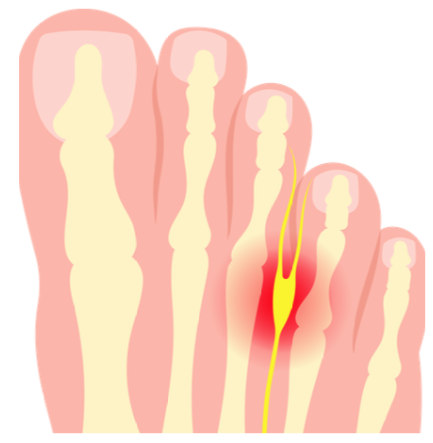- Customized Fit +
- Technology +
- Company +
Metatarsalgia is a condition characterized by pain and inflammation in the ball of the foot, the long bones in the front of your feet, just below the toes. It often feels like a sharp or burning pain and can be aggravated by activities such as walking or standing for long periods, running, or wearing improper footwear such as High-heels or tight shoes.
Morton’s neuroma occurs when the tissue surrounding one of the nerves leading to the toes becomes thickened or enlarged. This compression of the nerve can be attributed to various factors, including:

Inflammation (swelling)
Severe pain and numbness
The most common symptom of Morton’s Neuroma is pain located in the ball of the foot, frequently described as a sensation akin to burning or tingling. This discomfort may extend to the toes or other regions of the foot. Additionally, individuals affected by this condition might report sensations of numbness or a perception of an object lodged within their footwear.
Effective management of Morton’s neuroma involves a combination of conservative treatments aimed at reducing pain and inflammation, as well as addressing the underlying factors contributing to the condition. Here are some recommended management strategies:
Footwear Modification: Wear shoes with a wide toe box and low heels to reduce pressure on the forefoot and alleviate symptoms. Avoid narrow or tight-fitting footwear that can exacerbate neuroma pain.
Customized insoles: Custom-made orthotic inserts can provide support and cushioning to the foot, helping to redistribute pressure and relieve symptoms.
Padding and Taping: Use metatarsal pads or toe spacers to cushion the affected area and alleviate pressure on the nerve. Additionally, taping techniques can help stabilize the foot and reduce nerve compression.
Engage in stretching and strengthening exercises targeted at improving foot mechanics and reducing stress on the neuroma.
Ice Therapy: Apply ice packs to the affected area for 15-20 minutes several times a day to help reduce pain and inflammation.
Avoiding High: Impact Activities – Limit participation in activities that exacerbate symptoms, such as running or jumping, until symptoms improve.
Rest: Allow adequate rest periods to facilitate healing and reduce irritation of the affected nerve.
Morton’s neuroma can significantly impact an individual’s quality of life, but with proper understanding and management, the symptoms can be effectively controlled.
By addressing the underlying causes, modifying footwear, and wearing customized insoles made for your unique foot shape, individuals can experience relief from pain and discomfort associated with Morton’s neuroma.
Overcome foot disorders with a 100% CUSTOMIZED 3D PRINTED INSOLES that will perfect your motion and provide unparalleled support and relief for every step you take.
Stay updated on foot health matters, FeetTech’s most recent innovations, newsletter and special offers.
(786) 314 9094
Hours:
Monday-Saturday
10:00 am – 6:00 pm EST